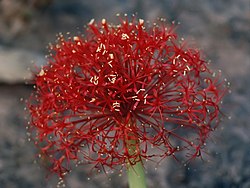Top Qs
Timeline
Chat
Perspective
Boophone disticha
Species of flowering plant From Wikipedia, the free encyclopedia
Remove ads
Boophone disticha is a bulbous tropical and subtropical flowering plant, endemic to Africa. Commonly called the century plant[4] or tumbleweed,[3] Boophone disticha was first collected in 1781 from South Africa by Swedish botanist Carl Peter Thunberg and described by Carl Linnaeus as Amaryllis disticha.[2] Since that time it has been placed in the genera Brunsvigia and Haemanthus, finally coming to rest as Boophone. The genus name itself was spelled in three different ways (Boophone, Boophane and Buphane) by the author William Herbert, straining the procedures of the rules of nomenclature. The etymology of the genus is from the Greek bous = ox, and phontes= killer of, a clear warning that eating the plant can be fatal to livestock.[5]
The genus as currently understood includes two or possibly three species. B. disticha is one of the most widely distributed bulbous species in South Africa, readily identified by its fan-like appearance of two tightly packed rows of about fifteen leaves in each row, and its up to 30 cm (12 in) diameter bulb half-protruding from the ground.[6] The Khoi, Bushmen and Bantu were aware of its poisonous nature and used parts of the plant medicinally and as an arrow poison. The principal compounds are eugenol - an aromatic, volatile oil smelling of cloves and having analgesic properties, and the toxic alkaloids buphandrin, crinamidine and buphanine, the latter having an effect akin to that of scopolamine and if taken in quantity may lead to agitation, stupor, strong hallucinations and (if over-ingested) coma or death.[7]
This species produces a single inflorescence, an umbel of about fifty pink, six-petaled flowers,[8] before the arrival of the season's new leaves. While maturing the fruiting head's pedicels undergo a stiffening process and remarkable elongation to some 300mm. When the fruiting head separates at its junction with the stalk, it forms a tumbleweed, easily moved by light breezes, scattering seeds as it rolls.
Remove ads
Native distribution and habitat
Boophone disticha is native to Angola, Botswana, Burundi, the Democratic Republic of the Congo, Eswatini, Kenya, Lesotho, Malawi, Mozambique, Namibia, Rwanda, South Africa (in the provinces of Eastern Cape, Free State, Gauteng, KwaZulu-Natal, Limpopo, Mpumalanga, Western Cape), Tanzania, Uganda, Zambia, and Zimbabwe.[1] It grows wild in dry savannas, grasslands, and glades in forests.[3]
Uses
Boophone disticha has been used locally to make an arrow poison and in the treatment of equine piroplasmosis.[9][10]
The bulb has a wide range of uses in traditional African medicine.[11] It contains alkaloids such as lycorine, undulatine, buphanisine, buphanamine, nerbowdine, crinine, crinamidine, distichamine, 3O-acetyl-nerbowdine, buphacetine and buphanidrine which have analgesic and hallucinogenic properties.[10]
Material from this species' bulb was associated with preservation of the Khoi Kouga mummy found in the Langkloof.
Remove ads
Gallery
Summarize
Perspective
Plant
- Edgeways view of young inflorescence emerging from bulb charred by bush fire
- Same bulb, flatways, showing inflorescence sandwiched by broad bracts
- Buds of young inflorescence having emerged from enclosing bracts
- Mature inflorescence (flowers open), showing basal bracts and embryonic leaf fan
- Densely-packed flowers: contrast of deep pink flowers and white anthers
- Flowers viewed in profile, showing trumpet shape and protruding stamens
- Single mature, closed flower bud
- Single bursting flower bud revealing long white anthers
- Single flower with half-concealed monkey beetles
- Small stand of bulbs - 3 in flower, one running to seed
- Lone bulb growing on recently-burned upland meadow
- Single bulb growing chasmophytically on dolomitic limestone in light shade
- Habit of ripening, tumbleweed-type infructescence
- Close-up of infructescence
- Detail of elongated pedicels and 3-angled seed capsules
- Close-up of ripe 3-horned capsules
- Single, dehiscent, tricorn seed capsule revealing 3 seeds
- Large (circa 1 cm) globose seeds (with scale reference)
- Young leaf fan emerging from bulb charred in brush fire
- Mature leaf fan, showing characteristic distichous phyllotaxis
- Atypical specimen, showing simultaneously inflorescence, leaves and last year's dead leaves
Insect visitors
- Larvae of Diaphone eumela, the Cherry Spot Moth, feeding on inflorescence
- Diaphone eumela (Cherry Spot/Lily Borer) adult
- Adults of the scarab beetle Cyrtothyrea testaceoguttata mating on inflorescence
- Long-shot of inflorescence covered in mating Cyrtothyrea testaceoguttata
- Scarab (Monkey beetle sp.) clinging to centre of single flower
References
External links
Wikiwand - on
Seamless Wikipedia browsing. On steroids.
Remove ads




























